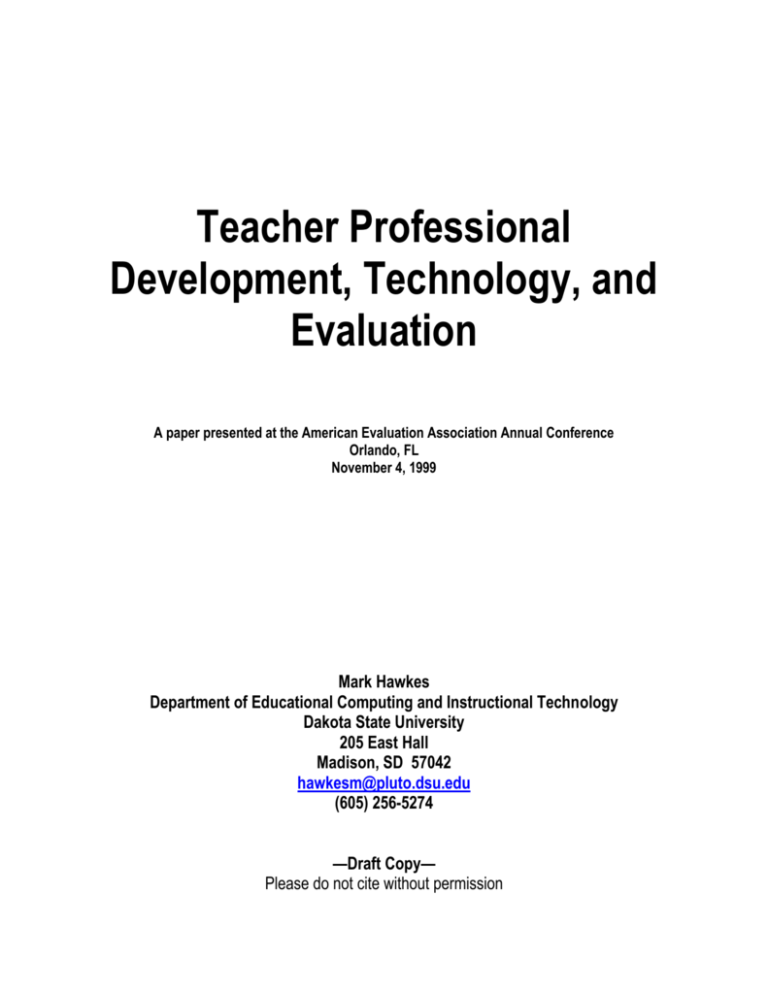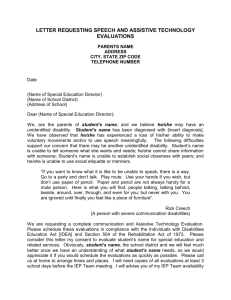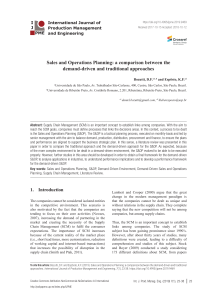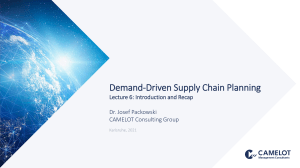Teacher Professional Development, Technology, and Evaluation
advertisement

Teacher Professional Development, Technology, and Evaluation A paper presented at the American Evaluation Association Annual Conference Orlando, FL November 4, 1999 Mark Hawkes Department of Educational Computing and Instructional Technology Dakota State University 205 East Hall Madison, SD 57042 hawkesm@pluto.dsu.edu (605) 256-5274 —Draft Copy— Please do not cite without permission Teacher Professional Development, Technology, and Evaluation There are substantial reasons why many evaluators embrace theory-based evaluations. A primary reason is might be the hint of promise theory-driven evaluations show for strengthening the validity of evaluations. Uses of program theories to guide evaluation activities, however, have primarily been a practice of the health promotion and risk prevention fields (Weiss, 1996). Education has been slower to employ theory in evaluation—and scarce is the application of theories to guide the evaluation of teacher development programs especially in the remarkably visible and rapidly growing domain of educational technology. New roles for educational technology in teacher development are emerging that challenge traditional approaches to development. Rapid shifts are being implemented in the way schools, districts, and states think about inservice teacher development. These shifts have much to do with recent research that indicates teachers learn best in a shared learning context. There are a number of key theoretical constructs from "shared knowledge" or constructivist theory that can be applied when evaluating teacher development for technology integration. This paper begins with a brief review of practices over the last decade that have been used to build teachers’ professional knowledge and skill in using educational technologies. The discussion continues with some ideas for maximizing technology’s effect by introducing a demand-driven concept of professional development oriented specifically toward the utilization of technology for teacher learning. The constructs that a demand-driven approach to development implies are then viewed briefly as possible criteria for evaluating teacher professional development in technology use. 2 General Strategies for Teacher Professional Development Professional development for teachers constitutes formal and informal processes of knowledge and skill building. Characteristically, inservice professional development has involved the pursuit of advanced degrees, school- and districtwide meetings at conferences and workshops, and personal study on selected topics using library resources (Rallis, Rossman, Phelgar, & Abeille, 1995. p.48). Teacher inservice has been a steady characteristic of U. S. education over the last several decades, and in being so, inservice practices are closely monitored for their ability to meet teachers’ developmental needs and to improve the process of learning in the classroom. As the call for systemic school improvement grows, teacher professional development is viewed with increasing interest. The increased emphasis on teacher development is probably partly due to the growing recognition by stakeholders that schools cannot be improved without properly improving the skills and abilities of the educators within them (Guskey & Huberman, 1995). Moersch (1997) notes that in developing the technology infrastructure in our nations schools a primary investment needs to be made in assessing teacher development needs and addressing them. The increased importance placed on high-quality ongoing teacher development was underscored with the enactment of the GOALS 2000: Educate America Act of March 1994. The National Educational Goals are a product of the 1989 summit that convened the nation’s governors and President Bush on the topic of how best to prepare all Americans to meet the challenges of the 21st century. The fourth of those six goals calls for teacher access to programs focused on improving professional skill and acquiring knowledge needed to prepare students for the next century (U.S. Department of Education, 1996). The Educate America Act interprets the 3 goal as professional development that is “ongoing, intensive, and an integral part of the teacher’s regular work day” (U.S. Department of Education, 1996). Renewed interests and new perspectives of teacher professional development as illustrated in the Educate America Act and other local, state, and federal programs suggests new strategies for addressing teacher development should be explored. Such strategies would go beyond the training model and attempt to encourage grassroots involvement in identifying and addressing learning needs while employing collaborative processes in professional development. It is still a debatable notion that educational technologies offer the collaboration and ongoing teacher development theorists call for. Part of the doubt directed at technology toward accomplishing those goals has to do with the lack of access the teaching force has to the technology. However, a recent study conducted by the National Center for Education Statistics (1999) indicates that during the school year of 1998, 89 percent of the nation’s public schools provided teachers with World Wide Web, e-mail, and newsgroup access, and resource location services (e.g., Gopher, ERIC, Archie, Veronica1). That’s up 12% from the year before. By next year access to network technology is expected to be available for 95% of the teachers nationwide. In addition to access at school, this decade of the technology revolution finds the teaching force as one of the fastest growing segments of the general population gaining access to online technologies at home (Harvey & Purnell, 1995). In isolated studies, educational technologies have proved efficient at addressing some of the shortcomings of traditional teacher development. Technology has served as a useful tool for facilitating a new kind of teacher professionalization through collaboration (Hawkes, 1999; McMahan, 1996; Wu & Nicholson, 1997). Educational technologies have also facilitated 1 Archie, Gopher, and Veronica are Internet search tools used to find host computers that have data or information that can be transferred to your computer. 4 customized development activities tailored to fit the needs and interests of individual teachers (Mehlinger, 1999; Serim, 1996). As well, the use of technology has allowed professional development activities that are ongoing and uniquely embedded in the experiences of teaching (Sparks, 1998; Moller, 1998; Topper, 1997). Though research shows that the instrumental uses of technology do improve the nature of teacher development at some level, evaluation struggles to show these outcomes are systemically observed. Evaluations of teacher development for technology use rely heavily on self-report in response to questionnaires and single, brief interviews, techniques that have been criticized s inadequate for the purpose of uncovering forms of knowledge that are not easily accessible (Nisbett & DeCamp-Wilson, 1977). Common evaluations, for the most part, are concerned with general issues related to teaching. While identifying common attitudes and habits related to technology use in the classroom, evaluations “survey the issue on the surface, offering little insight into how teachers’ personal beliefs in combination with the contextual conditions influence their practice” (Cooperman & Black, 1999). Not all evaluators would agree that a change in the nature of the evaluand would necessitate a change in evaluation questions. Yet because questions linked to guiding theory are well suited to the task of guiding ongoing program development, perhaps questions should be developed with theory in mind. One key guiding question—almost a universal one—would certainly address the larger educational purposes served with the infusion of technology. But to help educational technologies realize their full capacity in facilitating teacher professional development, a new generation of questions paralleling a new generation of teacher development should be considered. 5 A Demand Driven Model of Teacher Development There are many reasons to believe that the value of educational technology lies in helping teachers meet the increasingly numerous and complex tasks required of them in the classroom. Were it to purposefully serve teacher needs, technology’s infusion into professional development would match teachers’ real-life concerns, be available just at the time they need it most, build on the paths that other educators have forged, align with teachers varying skills levels and be ongoing. The use of technology for facilitating teacher learning contrasts with current situations where teachers toil all day with very little intellectual stimulation to learn. Technology opens new avenues for thinking together. Based on discourse of researchers and other expert groups, coupled with the observation and evaluation results of several professional development products and processes currently being tested, a demand-driven model to teacher development is emerging. This model, though not fully functional in any one site, has features with unique potential to address teacher preparation through and for technology application (Hawkes & Wilber, 1999). The features of this emerging development model relegate technology to a support role, emphasizing the process of improving instructional practice. It is designed to meet teachers’ information needs right as they materialize in the classroom. Such a demand-driven system would gather, organize and present a suite of cutting-edge information access and manipulation tools teachers require in their own and their students’ learning environment. A demand-driven/just-in-time approach to professional development engages teachers in reflective understanding of what they do in their classrooms, how they do it, and how they could do it better. It would help teachers narrow in on the topic of their interest and define their research or curriculum questions. In this way, the demand-driven system would help users 6 personalize their own professional development. It would be guided inquiry, available at the fingertips. The system also would mark trails teachers have previously forged so new inquirers can capitalize on that work or even take it in unprecedented directions. The model is interactive, allowing users to pose challenges, questions or scenarios into a common database. In this way, the system would draw on the intellectual base of experienced teachers. It would recognize these teachers’ skill in identifying key instruction process and content issues, and in presenting them in ways that make sense to their peers. This broad-level connectivity is critical to just-in-time technology capacity building. The design would accomplish two essential outcomes: It would model collaboration in a way that illustrates how students might be engaged in the learning process, and It connects teachers with peers who have vastly differing levels of expertise and divergent teaching beliefs. For example, teachers who are at different places on the continuum of adoption/application of technology could collaborate on real curriculum issues they face. This could generate opportunities for practitioners to be mentored (via peer coaching or even student-led guidance) during the school day. Similarly, since teachers’ approaches to technology use often stem from pre-existing pedagogical beliefs, just-in-time collaborative technology development can address or complement those beliefs at a level familiar to the teacher. As it is developed, the model could expand to meet the needs of policymakers from the school board level to the state house, as well as legislators, parents and others. Providing support 7 to all stakeholders in school reform would enhance mutual understanding of the issues pertinent to each group, thereby facilitating progress. Broadly stated, the objective of a demand-driven model to teacher professional development is based on intentionality (Jonassen, 2000). This model’s intention lies in knowledge-building. Being so, the emphasis is in linking technology-based solutions to content learning. Because the majority of current discussion around developing teachers’ professional capacity centers on the technology—we perpetuate the assumption that technology is something separate from the learning experience. When learning is the object of discussion, however, technology is embedded in the development of knowledge. The demand-driven model of teacher development considers technology to be the means of mediating a form of activity that teachers have not engaged in before. Instead of talking about where and how technology fits into teacher professional development, the dialogue is about what it is teachers want to accomplish in terms of student learning outcomes. The design of teacher development suggested here centers on awareness of the power and application of technology in the classroom, not just a “technology” curriculum. The model implies that professional development should take place every day, all the time. It encourages teachers to work together to collaborate on real curriculum issues facing them and their students. Implications for Evaluation Though only a glimpse of the not yet completely articulated demand-driven approach to teacher development is provided here, it is enough to consider how we might go about evaluating such an approach to teacher development. These criteria evolve from the model itself with a specific attempt to avoid becoming a list of fixed knowledge competencies. The rapidly 8 evolving nature of educational and telecommunications technology suggests that fixed competencies are relevant only for the acquisition of general foundational skills (keyboarding, point and click, systems operation, navigating). The criteria presented here attempts to keep teacher and learning foremost. The criteria listed below are framed as evaluation questions. They are overlapping with an attempt to build some internal consistency between the dimensions. These questions, however, can take a variety of forms and should net be limited by what is asked here. Each criterion is accompanied by brief elaboration. Evaluation Criteria: Does the Development . . . Provide ubiquitous access to telecommunication tools? Elaboration Access to the hardware and software that support change is critical. Interaction in the form of coaching, mentoring, and critical friendship encourage teacher professionalization. Encourage teacher understanding of the research process? Much of technology focused and infused professional development is solution oriented. The focus on the research process puts knowledge into teachers’ hands through the process of inquiry. Involve teachers in collaborative, knowledge-building communities? Leveraged in the right way, the powerful connectivity of network resources can bring teachers together to share collective knowledge on educational policy, subject area, and professional community. Model authentic, inquiry-based, engaged learning? New technology tools can help us create the kind of situations where teachers are taught exactly the same way we hope they teach their students. That is, to model the process along with the content. 9 Offer just-in-time support? Information is often most useful when it is just enough, just in time. Demand-driven development gets teachers quickly to the point where their students are doing interesting work that is clearly facilitated by the technology. And, it builds skills en-route to the instructional outcomes. Honor the K-12 teachers’ knowledge base? A quality professional development approach finds ways to reflect back the wisdom of the most talented teachers. Structures are needed (mentor/communication) that pass that knowledge to new generations of educators. Encourage teachers to integrate and share the documentation of their practice? There is increasing teacher awareness that documenting practice in the place where they work is an important and powerful tool to help teachers understand how to improve their teaching. Development that not only helps teachers document their practice, but finds ways to make it interchangeable helps leverage relevant knowledge—which is a repeated theme throughout this approach. Evaluators can be of special help here by helping build a common pattern language among practitioners and between practitioners and evaluators for identifying learning outcomes. Respond to issues unique to the context in which the technology is embedded? Learning itself contains so many interacting variables that without unique learning goals and benchmarks that measure them, the penetrating effects of the technology may not be fully noticeable. Show how technology is and isn’t capable of facilitating learning outcomes? Technologies adaptations are limited and knowing those limitations are key to helping teachers manipulate the technology to serve their own and their students learning needs. Address teachers’ personal assumptions about teaching, learning, and schooling? Most development programs link technology integration to external factors such as administrator support or time to practice. An understanding of how teachers’ perceptions about schooling are affected by technology integration is a basis for productive development activity. 10 Clearly show how other teachers address problems, situations, and opportunities on common occasions and in common areas of interest? This question inquires after the presence of a dynamic intelligent data base that gathers, organizes, and displays teacher experiences in addressing common issues. A registry of collective, evolving wisdom. These criteria are not unique to many past and present evaluations. And a few of these criteria have found their way into evaluations of technology programs on a somewhat consistent basis. But taken together, as a set of guiding evaluation questions that target learning experiences as opposed to hours of training on certain types of applications, these criteria are rather distinct. Summary The frequent change in evaluation questions addressing the outcomes of technology on teacher development are partly due to the rapid cycles of innovation that technology tools have undergone. This iteration of evaluation questions could likely be the next stage of that cycle. Educators, evaluators, and developers of measurement instruments struggle to keep current with the rush of information needs having to do with technology’s effectiveness. By casting key evaluation questions from the vantage of teacher development rather than technology capacity, we may be able to avoid that process that often makes our evaluation questions obsolete. Finally, the last year or two has marked a recent shift in schools’ focus on technology. Where once the emphasis was on building and implementing a technology infrastructure, today it is on evaluating the effectiveness of its use in school and classrooms. Parents and teachers, school boards and administrators, governors and state legislatures, and Congress all want to know if their nation’s investment in technology is providing a return in student achievement and 11 teacher development. The pressure is on to show that technology has a positive impact on what students learn and how teachers teach. 12 References Cooperman, N., & Black, J. (1999). First connections: The interactions between teachers’ pedagogical beliefs and their early use of the Internet in the classroom. Paper presented at the annual meeting of the American Educational Research Association, Montreal, Quebec, Canada. Guskey, T. R., & Huberman, M. (1995). Professional development in education: New paradigms and practices. New York: Teachers College Press. Harvey, J., & Purnell, S. (1995). Technology and teacher professional development (DRU-1045CTI). Santa Monica, CA: RAND Hawkes, M. (1999). Exploring network-based communication in teacher professional development. Educational Technology 39(4), 45-52. Hawkes, M., & Wilber, D. (1999). Preparing Teachers to Use Technology. North Central Regional Educational Laboratory. Oak Brook, IL. Jonassen, D. H. (2000). Computers as Mindtools for Schools: Engaging in Critical Thinking. Columbus, OH: Merrill-Prentice Hall. McMahon, T. A. (1996). From isolation to interaction? Computer-mediated communications and teacher professional development. Unpublished Dissertation, Indiana University, Bloomington, IN. Mehlinger, H. (1999). Research and features of technology development for teachers. Presentation given at the Forum on Preparing Teachers for Technology Application, North Central Regional Educational Laboratory, Oak Brook, IL. Moersch, C. (1997). Measuring the instructional use of technology. Learning and Leading with Technology, 32(1), 100-106. Moller, L. (1998, March). Designing communities of learners for asynchronous distance education. Paper presented at the annual meeting of the American Educational Research Association, San Diego, CA. National Center for Education Statistics. (February, 1999). Internet Access in Public Schools and Classrooms: 1994-98. Washington DC: US Department of Education. Available online: http://nces.ed.gov/pubsearch/pubsinfo.asp?pubid=1999017 Nesbitt, R., & DeCamp Wilson, T. (1977). Telling more than we can know: Verbal reports of mental processes. Psychological Review, 84(3), 231-259. Office of Technology Assessment, U.S. Congress (1995). Teachers and technology: Making the connection (OTA-EHR-616). Washington, DC: U.S. Government Printing Office. 13 Rallis, S. F., Rossman, G. B., Phelgar, J. M., & Abeille, A. (1995). Dynamic teachers: Leaders of change. Thousand Oaks, CA: Corwin Press. Serim, F. (1996). Building virtual communities for professional development. Online Internet Institute: The Future of Networking Technologies for Learning WWW [Online].Available: http://www.ed.gov/Technology/Futures/serim.html. U.S. Department of Education (1996). Achieving the goals: Goal 4 teacher professional development. Available: http://www.ed.gov/pubs/AchGoal4/. Sparks, D. (1998). Using technology to improve teaching and staff development: An interview with Kathleen Fulton. Journal of Staff Development, 19(1), 18-21. Topper, A. G. (1997). Comparing face-to-face and electronic discourse: Issues and questions raised in a research study. Paper presented at the annual meeting of the American Educational Research Association., Chicago, IL. [Online]. Available: http://www.educ.msu.edu/homepage/topper/ AERA_1997.htm. Weiss, C. H. (1996). Theory-based evaluation: Past, present, and future. Paper presented at the annual conference of the American Evaluation Association, Atlanta, GA. Wu, K., & Nicholson, S. (1997, March). In pursuit of socioemotional support: Participation patterns of ESL teachers on a teacher education computer network. Paper presented at the annual conference of the American Educational Research Association, Chicago, IL. 14










